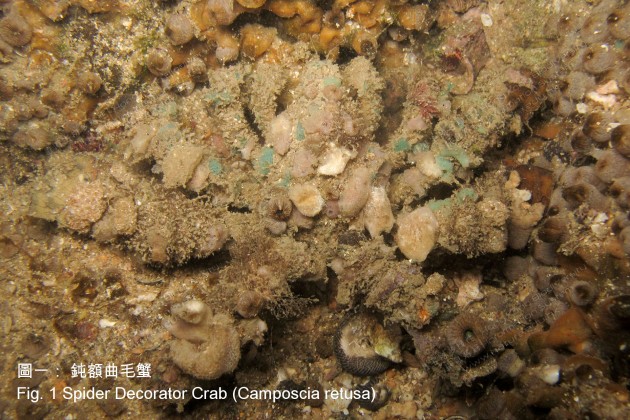禦敵 Defense
26-11-2015
為求生存,生物必須避免或應對周遭的危險。防禦,是生物應付敵對生物(主要為捕獵者)的方式。 防禦分不同層次:
1.免被察覺
「預防勝於治療」﹣對付敵人的最佳方法,往往是避開對方的耳目。達到這目的的方法主要有兩種—保護色和擬態。
保護色指生物體表的顏色、斑紋、質感等與環境相似。鈍額曲毛蟹(Camposcia retusa; 圖一)是運用保護色的一個好例子,他們生活在岩質的海床和海岸,會就地取材,將周圍的生物—如海葵、海綿、海藻等—黏貼在自己身上,以達至隱身的效果。
某些擬態生物的模仿對象是死物,如竹節蟲(䗛目;圖二)和部分毛蟲模仿枯枝枯葉(圖三)。
其他擬態生物則會模仿別的生物。某些鳳蝶(鳳蝶科)的幼蟲(圖四)除身體前端兩側各有一眼斑外,受驚時更會在頭頂伸出「蛇舌」,仿如樹枝上一條蛇。
另外,無毒的福清白環蛇(Lycodon futsingensis;圖五甲)身體黑白相間,驟眼看跟有劇毒的銀環蛇(Bungarus multicinctus multicinctus;圖五乙)難以分別。
2.威嚇
若被敵人發現,生物亦盡可能避免肉搏,減低受傷機會,故此威嚇是上策。威嚇亦分為外表上和行為上兩種。外表上的威嚇大多是靠警戒色。例如有毒素的香港瘰螈(Paramesotriton hongkongensis;圖六)的腹面有橙、黑的鮮豔斑紋。
某些生物亦會對敵人作出威嚇行為,例如令自身看似比實際大。三索錦蛇(Coelognathus radiatus;圖七)受驚時會向著敵人弓起並澎大身體前部。
3.埋身肉搏/同歸於盡
如不成功嚇退敵人,與對方死拚就免不了。很多蛙類受襲擊時會大量分泌黏液,有些更會吸入空氣澎大身體,令捕獵者難以吞食。刺蛾(刺蛾科)的幼蟲(圖八)身上長滿尖銳的毒刺,可要給捕食者狠狠的教訓一番。有些生物用上更強的化學防禦﹣步甲(步甲科)的腹部後部腺體會分泌具刺擊性甚至腐蝕性的液體,擊退敵人。
很多時候即使是難逃一死,故事亦未必就此終結。很多帶毒但不使用毒的生物,如千足蟲、斑蝶、部分兩棲類,到死那一刻,體內的毒素才終於派得上用場﹣該生物被吞食後,它體內的毒素隨即流入捕食者的血液裡,令捕食者中毒,甚至死亡。即使中毒而不死,捕食者亦可能學懂不再捕食犧牲者的同類,所以對犧牲者的同類來說,擁有毒素是一項防禦。
生物的防禦方法千奇百趣,絕不限於以上的介紹。牠們除了令觀賞生態更多姿多彩外,更令人體驗到生物爭扎求存強韌的生命力。
To survive, organisms must develop ways to avoid or counter dangers around them. We call the methods they use to cope with enemy organisms (mostly predators) “defence”. Defence can be classified into different levels:
1. Avoid being discovered
As the saying goes, “prevention is better than cure”. The best way to cope with enemies are often to conceal oneself and avoid being detected. To achieve this, there are mainly two ways – camouflage and mimicry.
Camouflage refers to the method in which an organism develops a body surface with colours, patterns and texture similar to the environment it inhabits. A good example of camouflage is the spider decorator crab (Camposcia retusa; Fig. 1), which inhabits rocky seabeds and seashores. They make themselves invisible by using local resources – sticking anemones, sponge and seaweed onto themselves.
Some organisms that perform mimicry (mimics) imitate non-living things. For example, stick insects (Order Phasmida; Fig. 2) and some caterpillars will mimic dead branches and leaves (Fig. 3).
On the other hand, some mimics make themselves look similar to other organisms. The caterpillars of some swallowtail butterflies (Family Papilionidae; FIg. 4) have two large eyespots on their frontal segment, one on each side. In addition to this, when threatened, they will also protrude a forked “snake tongue”, which makes them look like a snake curled on the branch.
Another example is the non-venomous Futsing Wolf Snake (Lycodon futsingensis; Fig. 5a), which is covered in black and white bands. A first glance it looks exactly the same as the venomous Many-banded Krait (Bungarus multicinctus multicinctus; Fig. 5b), so it is very difficult to distinguish between the two.
2. Intimidation
When discovered by an enemy, organisms will try their best to avoid a fight, and now intimidation becomes the best strategy. Intimidation is classified into two types – by appearance or behaviour. The former is often achieved by the use of warning colouration. For example, the toxin-secreting Hong Kong Newt (Paramesotriton hongkongensis; Fig. 6) has a bright orange-and-black pattern on their abdomen.
As for intimidation by behaviours, some organisms perform a threat display towards enemies, such as by making themselves look bigger than their actual size. The Copperhead Racer (Coelognathus radiata; Fig. 7), for instance, turns its front body into loops and inflates it while facing an enemy.
3. Fighting off enemies
If the strategy of scaring away the enemy fails, organisms will resolve to a fight until one side falls. A lot of frogs secrete large volumes of mucus when attacked, while some inflate their bodies. All these make them difficult to be devoured by predators. Slug moth (Family Limacodidae) larvae (Fig. 8) are covered with sharp stinging hairs, and are ready to punish any predator who dares to eat it. Some organisms have even developed chemical defence mechanisms. To fight off enemies, ground beetles (Family Carabidae) produce irritating or even corrosive secretions from the glands in the lower back of their abdomen.
Often times, the battle does not end, even when death is certain. There are many poisonous organisms that do not use their poisons outwardly, such as millipedes, milkweed butterflies, and some amphibians. It is only at the moment of death when the toxins in their bodies come in to use. After the organism is devoured, the toxins enter the predator’s blood and poison them, and may even lead to death. Even when the predator escapes its doom, it will learn not to prey on that poisonous species. Hence, from the species’ point of view, having toxins is a great defence mechanism.
Defensive strategies of organisms come in different fascinating ways and are, of course, not limited to those mentioned above. Not only do they make ecological observations more interesting, they also show us the amazingly strong will of organisms to survive.


















